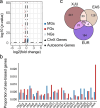Analysis of sex-biased gene expression in a Eurasian admixed population
- PMID: 39293802
- PMCID: PMC11410377
- DOI: 10.1093/bib/bbae451
Analysis of sex-biased gene expression in a Eurasian admixed population
Abstract
Sex-biased gene expression differs across human populations; however, the underlying genetic basis and molecular mechanisms remain largely unknown. Here, we explore the influence of ancestry on sex differences in the human transcriptome and its genetic effects on a Eurasian admixed population: Uyghurs living in Xinjiang (XJU), by analyzing whole-genome sequencing data and transcriptome data of 90 XJU and 40 unrelated Han Chinese individuals. We identified 302 sex-biased expressed genes and 174 sex-biased cis-expression quantitative loci (sb-cis-eQTLs) in XJU, which were enriched in innate immune-related functions, indicating sex differences in immunity. Notably, approximately one-quarter of the sb-cis-eQTLs showed a strong correlation with ancestry composition; i.e. populations of similar ancestry tended to show similar patterns of sex-biased gene expression. Our analysis further suggested that genetic admixture induced a moderate degree of sex-biased gene expression. Interestingly, analysis of chromosome interactions revealed that the X chromosome acted on autosomal immunity-associated genes, partially explaining the sex-biased phenotypic differences. Our work extends the knowledge of sex-biased gene expression from the perspective of genetic admixture and bridges the gap in the exploration of sex-biased phenotypes shaped by autosome and X-chromosome interactions. Notably, we demonstrated that sex chromosomes cannot fully explain sex differentiation in immune-related phenotypes.
Keywords: Xinjiang’s Uyghurs; genetic admixture; local ancestry inference; sex-biased genes.
© The Author(s) 2024. Published by Oxford University Press.
Figures





Similar articles
-
Genomic diversity and post-admixture adaptation in the Uyghurs.Natl Sci Rev. 2021 Sep 11;9(3):nwab124. doi: 10.1093/nsr/nwab124. eCollection 2022 Mar. Natl Sci Rev. 2021. PMID: 35350227 Free PMC article.
-
Genetic History of Xinjiang's Uyghurs Suggests Bronze Age Multiple-Way Contacts in Eurasia.Mol Biol Evol. 2017 Oct 1;34(10):2572-2582. doi: 10.1093/molbev/msx177. Mol Biol Evol. 2017. PMID: 28595347
-
Inferring the population history of Kyrgyz in Xinjiang, Northwest China from genome-wide array genotyping.Am J Biol Anthropol. 2023 Aug;181(4):611-625. doi: 10.1002/ajpa.24794. Epub 2023 Jun 13. Am J Biol Anthropol. 2023. PMID: 37310136
-
The impact of sex on gene expression across human tissues.Science. 2020 Sep 11;369(6509):eaba3066. doi: 10.1126/science.aba3066. Science. 2020. PMID: 32913072 Free PMC article.
-
The conneXion between sex and immune responses.Nat Rev Immunol. 2024 Jul;24(7):487-502. doi: 10.1038/s41577-024-00996-9. Epub 2024 Feb 21. Nat Rev Immunol. 2024. PMID: 38383754 Free PMC article. Review.
Cited by
-
Exploring How Adipose Tissue, Obesity, and Gender Influence the Immune Response to Vaccines: A Comprehensive Narrative Review.Int J Mol Sci. 2025 Jan 20;26(2):862. doi: 10.3390/ijms26020862. Int J Mol Sci. 2025. PMID: 39859575 Free PMC article. Review.
-
Ultrafast and Deep Saliva Proteome Reveals the Dynamic of Human Saliva With Aging by Orbitrap Astral Mass Spectrometer.IET Nanobiotechnol. 2025 Jul 7;2025:6616433. doi: 10.1049/nbt2/6616433. eCollection 2025. IET Nanobiotechnol. 2025. PMID: 40662159 Free PMC article.
References
MeSH terms
Supplementary concepts
Grants and funding
LinkOut - more resources
Full Text Sources
Miscellaneous

